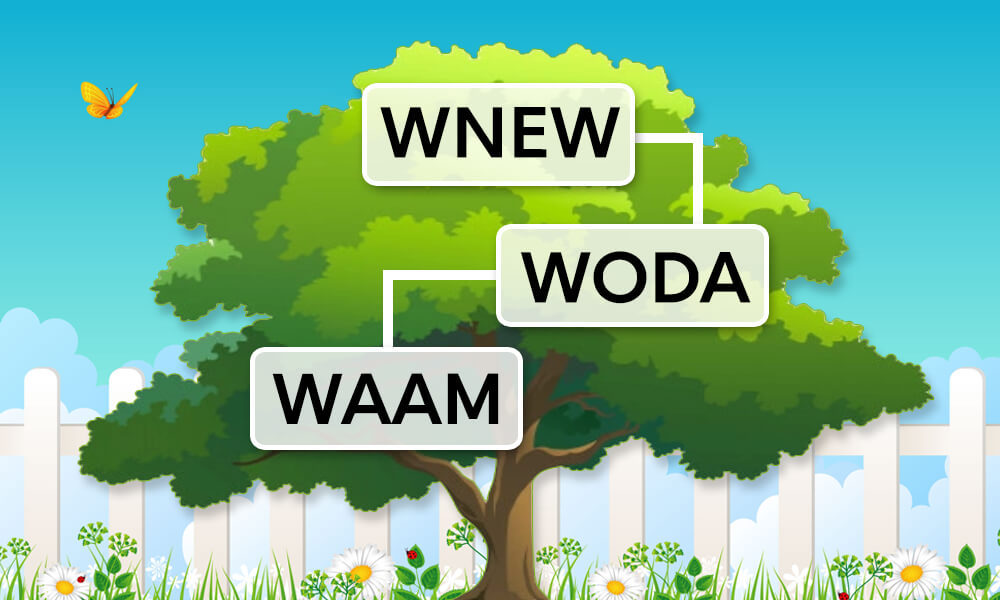Let’s say the trunk of the tree is the fledgling new industry of radio broadcasting. Eighteen months after KDKA Pittsburgh and WWJ Detroit — considered commercial radio’s first two stations — began operating in the latter part of 1920, things really began to happen with new stations flooding the AM radio dial.
Among those licensed by the middle of 1922 was WAAM in Newark, New Jersey, founded by the I. R. Nelson Company, about which I’ve found not one shred of information. It became the earliest branch of the WNEW family tree.

Then, by the middle of 1925, we find the other branch of the tree sprouting … station WODA begins operating in Paterson, New Jersey … licensed to the James K. O’Dea Radio & Victrola Shop, transmitting with 25-watts of power — not unusual for these early days — at 1340 on the dial.


However, a year later WODA is listed as licensed to the O’Dea Temple of Music, owned by one Richard E. O’Dea … still at 1340 kilocycles but having increased power ten-fold to 250-watts. (At the same time, WAAM is at 1140 kilocycles transmitting with 250-watts.)
All of this “investigation” began as the result of an email I received some weeks ago from a lady named Jennifer, who told me she is the granddaughter of Richard E. O’Dea and that her father is Dick O’Dea, (Dick O’Dea.com Outboard Boat Racing) whose name is closely tied to the history of boat racing! One thing immediately became evident: this was a family of entrepreneurial “doer’s,” not couch potatoes in any way. What I’ve not been able to learn is the connection between James and Richard O’Dea … father-son, brothers?
Another year later … in 1927, Richard O’Dea has moved WODA to 1020 and increased wattage to 1000-watts, a significant amount of transmitting power for this early time in radio broadcasting … when many stations were still operating in the 100 to 500-watt range. Meanwhile, WGCP — later to become WHBI — and the third station in the future frequency-sharing trio is now positioned at 1070 kilocycles, having been at 1190 a year earlier.
Come 1928, WODA continued at 1020 kilocycles — sharing it with a station licensed to nearby Secaucus, New Jersey — while the station it will ultimately merge with, WAAM Newark + the other Newark-licensed station which lived on in the WNEW years as WHBI, are listed as being at 1120 kilocycles.


By 1930, all three had moved in together at 1250, although operating with different transmitting power … WAAM had 2000-watts during daylight hours, 1000-watts after sunset. WODA was operating with 1000-watts during all of its operating hours while WGCP, soon to be WHBI, broadcast with only 250-watts.
Much of this is likely trivia, yet I cite it to show how transient broadcasting was in those early years … some may be attributed to inaccurate data, yet more likely is due to government-mandated changes brought on by stations permanently disappearing and others seeking a power increase. Also, keep in mind that few of these stations were being operated by persons with a real desire or ability to offer programming on a full-time basis; hence, sharing time with one or more other stations was not an issue … in fact, it was really better to be sharing a frequency so as to keep it “hot,” meaning having a signal emanating from that spot on the dial the more hours, the better.
I give Richard O’Dea credit for holding on to his ownership share when in 1934, the other owners — including famed vaudeville comedian and early TV personality Ed Wynn — of the merged stations, WODA and WAAM, which had created the Woodam Corporation just a year earlier, had sold out to the gentlemen, Milton Biow and Arde Bulova, who created WNEW.

Finally, 1250 kilocycles on the AM dial is where they’d stay until the grand re-shuffle of 1941 … which moved WHBI to 1280, to be joined by WOV, which switched frequencies with WNEW, with the latter moving to 1130 … made possible by the fact that WNEW and WOV were both under the ownership of Messrs. Biow and Bulova. (All of this latter information is shared in greater detail in the WNEW story, found in my last Musings.)
A final thought: Regarding those transmitting powers utilized back then? It was amazing what 250-watts could do in reaching out long distances … compared to today when there’s such interference caused mostly by electrical devices, it’s difficult for 50,000-watt stations to deliver a clear signal very many miles from their transmitters!
Much of this information about stations and their dial locations and power outputs were possible to research thanks to two individuals … Barry Mishkind who provided the data and Jeff Miller who organized and make it available.



Hi, Marlin. Thanks for another enjoyable history lesson. There's some great condensed history of WAAM (and WODA for that matter) in the terrific volume "The Airwaves of New York."
Be well.